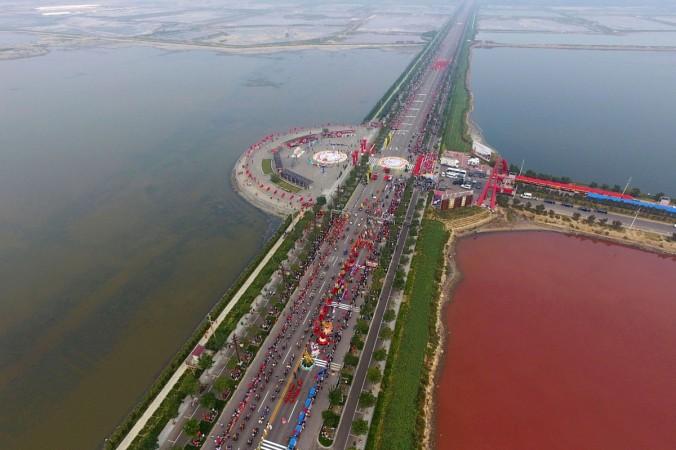
The ancient Yuncheng salt lake in China's Shanxi province has become a major tourist attraction because of its two different colours. The lake, which is known as the Dead Sea, has turned pink on one side, while the other side remains green.
The two-coloured salt lake covers approximately 132 square km and is said to be 50 million years old. The lake's prominent colours made it a popular tourist attraction in the Shanxi province attracting visitors from across the world.
"It looks beautiful," China's Xinhua news agency quoted a local resident as saying.
The world's third-largest sodium sulphate inland lake changes colour, particularly the shades of red, because of microorganisms called Dunaliella salina. The change in the colour of water might look unusual, but this has happened in several other countries. Dunaliella salina has been found in salt lakes in several other countries, including the US, Turkey, France, and last year in Iran.
The pink and green colours have lasted for many years and it disappears only in winter, according to Xinhua. The changes in the colour happen during the spring and early summer due to climate patterns.
The Dead Sea or the Yuncheng salt lake is one of the three largest sodium sulphate inland lakes in the world. The high salt concentration makes the lake similar to that of the Dead Sea, which allows people to float easily.
As temperatures rise, the salt lake in Yuncheng, north China's Shanxi province turns multicolored pic.twitter.com/MXJNInA9ap
— CCTV (@CCTV) July 14, 2017
Incredible changing colors of China's "Dead Sea." Yuncheng Salt Lake turns a reddish hue pic.twitter.com/OtZEX9YTx4
— China Xinhua News (@XHNews) September 20, 2017
The dropping temperature in autumn leads to the different colors appearing on the surface of Salt Lake in Yuncheng, Shanxi Province. ? pic.twitter.com/RqVy8oIdwT
— TravelChinaGuide.com (@tcg_travel) September 19, 2017
Iran's Lake Urmia is another lake that changes colour due to the microorganisms Dunaliella salina. While explaining the change in colour in Lake Urmia, Mohammad Tourian, a scientist at the University of Stuttgart explained to NASA that in the condition of high salinity the colour changes to red.
"In the marine environment, Dunaliella salina appears green; however, in conditions of high salinity and light intensity, the microalgae turns red due to the production of protective carotenoids in the cells," Tourian said in 2016.
Check the photos of China's Dead Sea below.


















